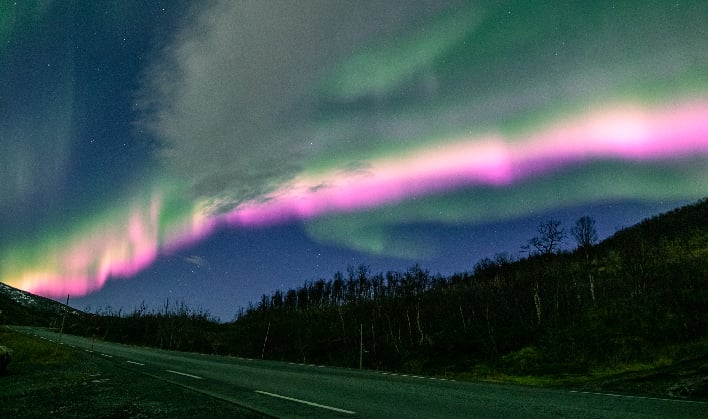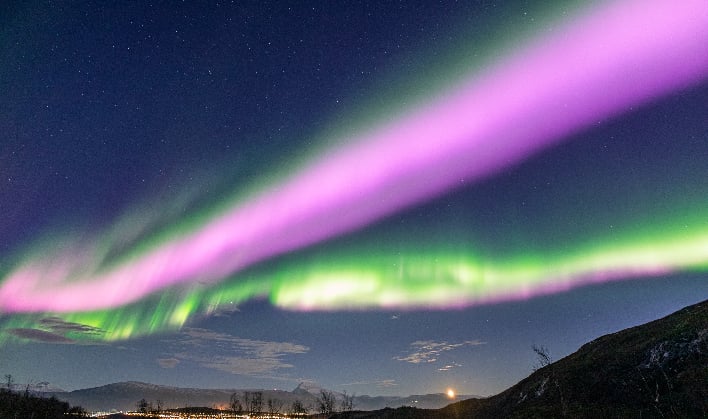Solar Storm Rips A Hole In Earth's Magnetosphere Causing These Ultra-Rare Pink Auroras
A G1-class geomagnetic storm on November 3rd ripped a hole in Earth's magnetic field, resulting in an extremely-rare explosion of pink and purple auroras. The magnificent event was captured by Markus Varik of Tromso, Norway.
Seeing stunning aurora lights after a geomagnetic storm is not anything unusual. Especially if you are a full-time guide who helps others to see the captivating Northern Lights. But guide Markus Varik and a group of sightseers were privy to a rare event on November 3rd as the night sky lit up as pink and purple streaks of light danced through the sky.
Varik is a tour guide with the Greenlander tour company based near Tromso in Norway. He shared his experience on the company's Facebook page where he showcased several pictures of the incredible event. The post stated, "If that post doesn't get record amount of likes/comments, I don't know, what does, haha."
"These were the strongest pink auroras I have seen in more than a decade of leading tours," remarked Varik in an interview with Live Science. "It was a humbling experience."
The rare event was a result of the Earth's magnetic field being disrupted by a G1-class geomagnetic storm. The storm lasted for more than 6 hours, allowing solar wind to enter Earth's atmosphere.
According to Spaceweather.com, pink auroras are a sign of nitrogen. While most auroras are green, the color of oxygen atoms slamming into energetic particles high above the Earth's surface, pink appears when those energy particles from space descend lower than normal. Because of the lower altitude, the energy particles strike nitrogen molecules instead.
As the magnetosphere hole closed, a peculiar blue ribbon of light emerged above Sweden following the pink aurora. Onlookers reported the strange light lingering motionless for around 30 minutes. Experts are not sure if the unique event was the first of its kind, caused by the weakened magnetosphere, or if it was the product of something else. One expert thought it could have been the result of a Russian rocket, but Spaceweather.com stated no rockets were seen in the area during that time.
Seeing stunning aurora lights after a geomagnetic storm is not anything unusual. Especially if you are a full-time guide who helps others to see the captivating Northern Lights. But guide Markus Varik and a group of sightseers were privy to a rare event on November 3rd as the night sky lit up as pink and purple streaks of light danced through the sky.
Varik is a tour guide with the Greenlander tour company based near Tromso in Norway. He shared his experience on the company's Facebook page where he showcased several pictures of the incredible event. The post stated, "If that post doesn't get record amount of likes/comments, I don't know, what does, haha."
"These were the strongest pink auroras I have seen in more than a decade of leading tours," remarked Varik in an interview with Live Science. "It was a humbling experience."
The rare event was a result of the Earth's magnetic field being disrupted by a G1-class geomagnetic storm. The storm lasted for more than 6 hours, allowing solar wind to enter Earth's atmosphere.
According to Spaceweather.com, pink auroras are a sign of nitrogen. While most auroras are green, the color of oxygen atoms slamming into energetic particles high above the Earth's surface, pink appears when those energy particles from space descend lower than normal. Because of the lower altitude, the energy particles strike nitrogen molecules instead.
As the magnetosphere hole closed, a peculiar blue ribbon of light emerged above Sweden following the pink aurora. Onlookers reported the strange light lingering motionless for around 30 minutes. Experts are not sure if the unique event was the first of its kind, caused by the weakened magnetosphere, or if it was the product of something else. One expert thought it could have been the result of a Russian rocket, but Spaceweather.com stated no rockets were seen in the area during that time.



